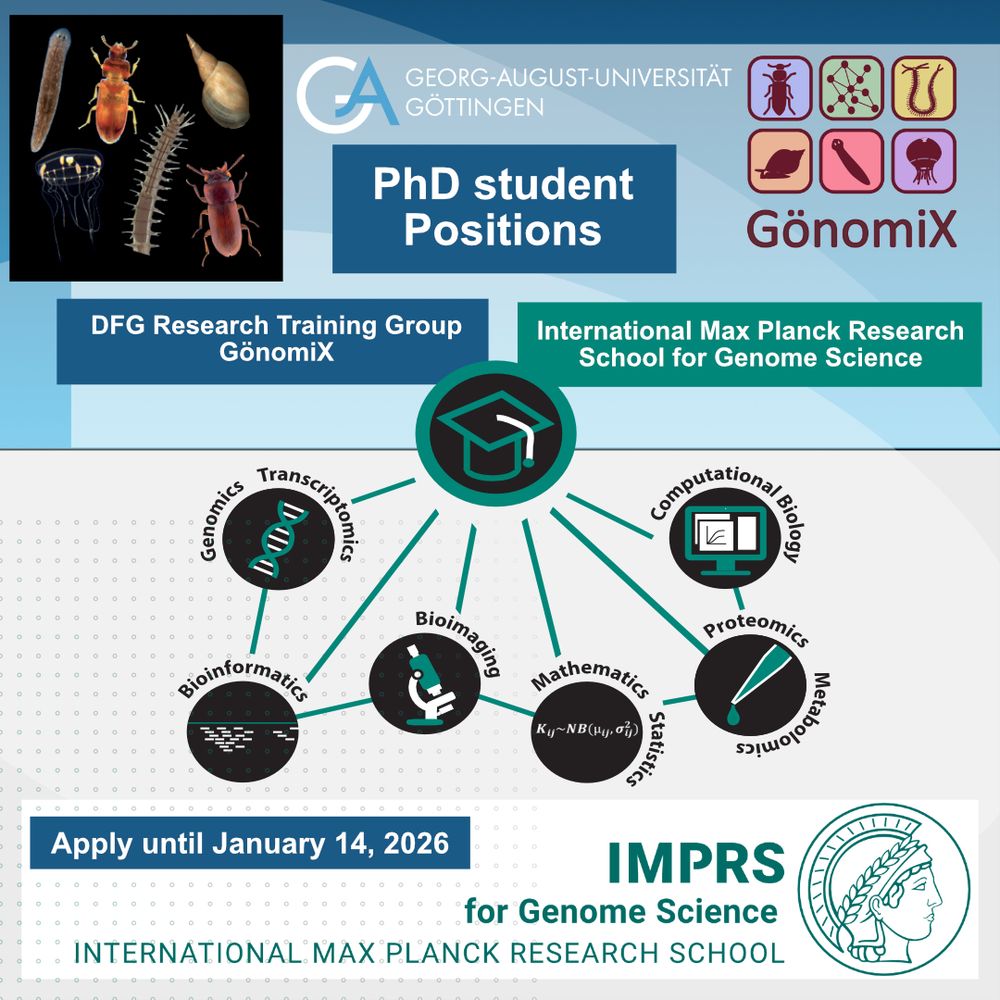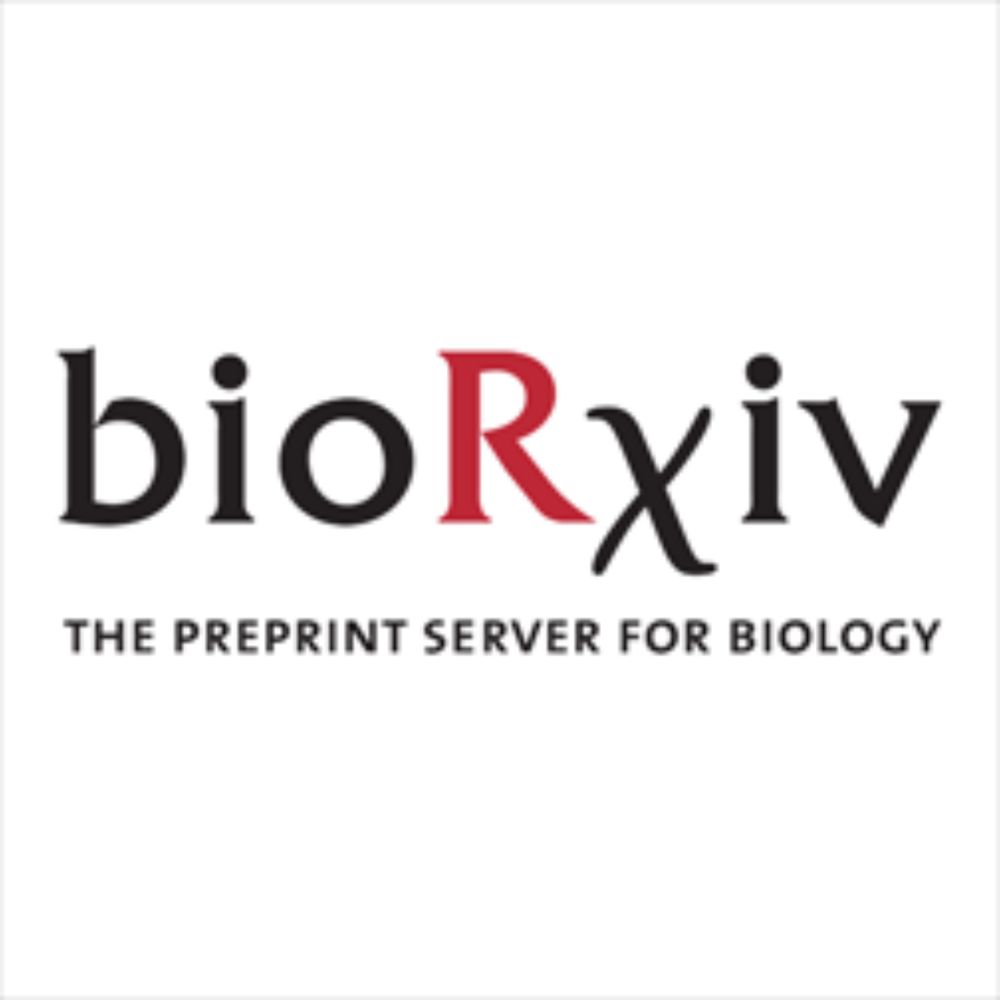Ich habe das ungute Gefühl, dass das keine Konsequenzen haben wird. #Gießen #GI2911
29.11.2025 08:20 — 👍 194 🔁 86 💬 8 📌 11
Die Polizei ist komplett entfesselt! Sie kennt keine Zivilisation mehr: Schädel-Hirn-Trauma, offene Brüche, sehr viele Krankenwagen danach. Die Polizei ENTZIEHT den friedlichen Demonstrierenden sogar den Schutz. So ist ein Auto in eine Menge gefahren!
Das Ganze muss ein Nachspiel haben!
29.11.2025 08:27 — 👍 648 🔁 218 💬 14 📌 14

Doctoral hat surrounded by icons representing genome science fields: math, bioimaging, genomics, bioinformatics & more. Logos for Uni Göttingen, GönomiX & IMPRS-GS.
Want to shape the future of genome science? 🧬 PhD positions available at Max Planck Institute & Uni Göttingen (IMPRS-GS/GönomiX)! Join a vibrant, interdisciplinary research community. Apply by Jan 14, 2026: www.uni-goettingen.de/de/applicati... #GenomeScience #Research
28.11.2025 12:23 — 👍 6 🔁 5 💬 0 📌 0
This is misinformation by default, so if you're a journal and you use AI slop for your cover or your announcements, you're not scientific in any way and should be shamed mercilessly 🧪
18.11.2025 14:07 — 👍 54 🔁 18 💬 1 📌 0
Posnien - Georg-August-Universität Göttingen
Webseiten der Georg-August-Universität Göttingen
🧬 PhD Position: Evolutionary & Comparative Genomics 🕷️
Join us at @uni-goettingen.de for a 3-year PhD (65% TV-L E13).
We will investigate the genomic & phenotypic impact of gene duplication across 233 arthropod genomes!
More infos 👇 and s.gwdg.de/eDrAAY
#Evolution #Genomics #Bioinformatics
18.11.2025 07:04 — 👍 23 🔁 29 💬 2 📌 0
Very excited to present OpenCGChromatin🔥🔥🔥
A new coarse-grained model that probes full chromatin condensates at near-atomistic resolution to reveal the molecular regulation of chromatin structure and phase separation
Brilliantly led by @kieran-russell.bsky.social, with the Rosen and Orozco groups
18.11.2025 15:07 — 👍 48 🔁 15 💬 2 📌 1

🧬 10 @dfg.de-funded PhD positions at @goettingen-campus.de 🧬
❗Focus: Evolution of gene regulatory networks & Wnt signaling in emerging models (insects, snails, flatworms, cnidarians).
💻 Methods: 'Omics, Bioinformatics, CRISPR/RNAi & Imaging.
📌Start: June 2026.
#EvoDevo #Genomics #Bioinformatics
18.11.2025 14:04 — 👍 10 🔁 8 💬 1 📌 1

Tumblr-Post: exwife-of-frankenstein
Yesterday
Youtube is full of ads, spotify is full of ads, tumblr is full of ads, pinterest is full of ads. Everything uses ai. Every new update makes the website/app worse. Youtube auto translates almost every video I want to watch. Sometimes pinterest only loads ads for me. Check out this new ai feature. Here's a new update that breaks ur phone. Why are u complaining about ur phone, just get the newest iphone lol. Join my patreon. Join my membership. Pay a monthly membership to get all features. Upgrade your membership to get even more features. Subscribe to netflix. Subscribe to disney. Subscribe to amazon. Subscribe to hulu. This content isn't available in ur country. This content was removed. This website was removed. This feature only exists for apple. U need a WiFi connection to play this game. This app only exists for apple. U need an account. We need your email to finish creating an account. We need your number to finish creating your account. We need your id to finish creating your account. In order to delete your account please write an email. In order to delete your account you need a laptop. Oops our database was hacked and ur information was stolen. Ur data was sold from this random website u used 10 years ago. Spam call. Spam call. Spam call.
01.11.2025 09:37 — 👍 229 🔁 54 💬 6 📌 5

The Closing Scientific Retreat of @spp2202.bsky.social is under way in Goettingen with Gerd Blobel delivering the first Keynote lecture on LDB11-mediated looping of chromatin.
10.11.2025 14:51 — 👍 10 🔁 2 💬 0 📌 0

📢 Last days to apply for our #PhD and #MDPhD programs! Become part of Basel, Europe’s #LifeScience hub, and grow in a dynamic, international, and supportive community. Apply by Nov 15: www.fmi.ch/education-ca...
10.11.2025 09:14 — 👍 6 🔁 4 💬 0 📌 0

Our latest paper has just been published in Cell!
doi.org/10.1016/j.ce...
We developed a new method called MCC ultra, which allows 3D chromatin structure to be visualised with a 1 base pair pixel size.
05.11.2025 17:17 — 👍 205 🔁 77 💬 6 📌 11
JD Vance claims that diversity weakens unions, as people end up distrusting each other and not organizing.
Let me tell you two menswear stories related to this claim. 🧵
30.10.2025 08:06 — 👍 8379 🔁 2722 💬 345 📌 793

Happy to share our latest publication, in which we show that the arrangement of nucleosomes around CTCF sites contributes to higher-order organisation of chromatin into TADs: www.embopress.org/doi/full/10....
27.10.2025 11:49 — 👍 71 🔁 31 💬 0 📌 2
Happy to report that the first part of my PhD work is published! Thank you to everyone involved!
27.10.2025 12:35 — 👍 10 🔁 1 💬 1 📌 0
"Genes, Traits, and Identities: Navigating Sex, Gender, and Sexuality in Modern Research"
Frequently the trans and intersex communities are excluded from population-based genomics studies because they cannot be put in a neat box. But sex is a complex trait, like many other traits we study #ASHG25
15.10.2025 12:34 — 👍 29 🔁 8 💬 2 📌 3
Deutsche Hunger Games
14.10.2025 13:50 — 👍 183 🔁 14 💬 8 📌 1

How do flexible regions of histone chaperones team up to handle histones? Together with Fred Winston’s lab
@harvardmed.bsky.social, we reveal new insights in our study just out in Mol Cell. Hats off to James Warner and Vanda Lux @iocbprague.bsky.social for their key contributions! dlvr.it/TNB145
21.09.2025 19:31 — 👍 14 🔁 9 💬 0 📌 1

Grafik, welche die Entwicklung der Vermögensverteilung in Deutschland seit 2010 zeigt. Der Anteil des Vermögens der oberen zehn Prozent am Gesamtvermögen steigt kontinuierlich an. Aktuell besitzen die oberen zehn Prozent der Bevölkerung 11,4 Billionen Euro, die unteren 50 Prozent lediglich 0,48 Billionen Euro (Stand: 1. Quartal 2025, Quelle: EZB).
In kaum einem Land ist Vermögen so ungleich verteilt wie in Deutschland. Die reichsten zehn Prozent der Bevölkerung besitzen sagenhafte 11,4 Billionen Euro – und werden immer reicher. Sparen aber will die Regierung bei den Ärmsten.
www.t-online.de/nachrichten/...
17.09.2025 07:20 — 👍 750 🔁 402 💬 32 📌 15

PhD position in Gene Regulation
Are you excited about studying the crucial process of transcription? Join our supportive, young and growing team!
As part of this grant, I have a vacancy out for a PhD student to join our super nice team. It closes on September 9 (Tuesday).
If you are or know a good prospective PhD student, excited about studying transcription, please (suggest them to) apply here: www.uu.nl/en/organisat...
04.09.2025 11:48 — 👍 7 🔁 5 💬 1 📌 0
Our new preprint is out!
We combined single-nucleosome imaging and 3D-SIM to reveal:
🔹 Euchromatin forms condensed domains, not open fibers
🔹Cohesin loss increases nucleosome mobility without decompaction
🔹Cohesin prevents neighboring domain mixing
Full story & movies👇
28.08.2025 15:11 — 👍 19 🔁 7 💬 3 📌 1
YouTube video by SWR Wissen
Was ihr noch NICHT über den Eisprung wusstet! | SWR Wissen
Tabea Marx from the Department of Meiosis @schuhlab.bsky.social talks about the group’s ovulation research in the new SWR Wissen video (in German)! Why is ovulation research so challenging for scientists? What did the team find out? Watch the video to learn more👇
www.youtube.com/watch?v=UDz-...
27.08.2025 14:44 — 👍 4 🔁 2 💬 0 📌 1

Oscillatory pattern of chain extension and nucleosome self-association with variation in protein-free DNA linker length in simulated nucleosome-decorated DNA chains. Regular structures bearing 15 nucleosomes constructed from the mean rigid-body parameters between successive base pairs; nucleosomal cores depicted as wedge-shaped objects and color-coded to highlight the two- and three-start organization of the structures. Nucleosomal DNA constrained to the 147-bp pathway found in the best-resolved core particle structure, pdb_id 1kx5

Distortions in the average structures of simulated nucleosome-decorated DNA chains introduced by changes in the positioning of a singe nucleosome. A. Local opening and unpacking of a compact array introduced by a single 2-bp increment in the spacing between nucleosomes. B. Kinking of an extended array by a single 5-bp increment in nucleosome spacing.

Effects of the nucleosomal DNA pathway on the average configurations of simulated 12-nucleosome arrays. Average structures bearing the undertwisted DNA found in the best-resolved core particle structure, pdb_id 1kx5, compared to the overtwisted DNA found in the RCC1-nucleosome complex, pdb_id 3mvd. The regulatory protein is not included in the simulations. Upper views looking perpendicular to the chromatin axis and lower views down the axis

Molecular 'snapshots' illustrating the potential effects of chain length and nucleosome positioning on large-scale chromatin folding. A. Smoothly deformed array of 78 nucleosomes with uniform 177-bp spacing. B. 77-nucleosome chromatin 'copolymer' containing three stretches of nucleosomes with different spacings: a compact array of 26 nucleosomes (deep brown) with 172-bp spacing at the 5́-end of the chain; an extended array of 26 nucleosomes (light brown) with 177-bp spacing in the middle; an opened array of 25 nucleosomes (yellow) with 207-bp spacing and a nucleosome-free gap at the 3́-end of the chain. Note the more pronounced junction between ‘helical’ stretches when the spacing changes by roughly a half turn of DNA (172 – 177 = –5 bp) than when altered by a multiple of the double-helical repeat (207 – 177 = 30 bp). The presence of a nucleosome-free gap, within the stretch of nucleosomes spaced at 207-bp intervals, enhances the flexibility of the modeled structure, allowing the chain to bend in various directions
Contributions of local structural and energetic features of DNA to large-scale genomic organization [perspective by Wilma Olson & Co) www.sciencedirect.com/science/arti...
23.08.2025 11:32 — 👍 11 🔁 5 💬 0 📌 0
Scientist in progress. Post-Doc at UMass Chan Medical School. Working with spatial epigenomics.
Biochemist fascinated by visualizing biological processes with the finest spatiotemporal detail; Understand the human immune system to guide novel approaches for combating viral infections and cancer; Postdoc at Cissé Lab / MPI-IE
Group Leader in Structural Biology - Imperial College London | Views my own
🔗 https://profiles.imperial.ac.uk/s.rengachari
🔗 https://orcid.org/0000-0003-4237-8258
Our long-term research goal is to understand and predict gene regulation based on DNA sequence information and genome-wide experimental data.
mRNA & cryo-EM enthusiasts at IMP Vienna. Posts are by lab members.
New PI @mpi_ie, interested epigenetics, development, homologous chromosome interactions and their function (she/her)
Scientist at IMP in Vienna. Excited about gene expression regulation and its encoding in our genomes - enhancers, transcription factors, co-factors, silencers, AI.
We explore cell fate and plasticity - to bridge the gap between basic research and clinical application @lmumuenchen.bsky.social (LMU), Germany. #cell #biology #biomedical #science / Impressum: http://tinyurl.com/59k5d95t
https://www.med.lmu.de/bmc/en
Ja, das ist mein Klarname!
Bundeslandhass muss Bürgerrecht werden!
Remember remember, the eighth of November!
Herbstfreak!
She/her
KEINE KOMPROMISSE!
MENSCHENRECHTE SIND KEINE VERHANDLUNGSMASSE!
Milkiest Man In Esports Entertainment. Find my rants on https://www.youtube.com/@PleasantKenobi
Chemist, blogger and science journalist. Physical sciences editor for Spektrum der Wissenschaft.
Writes about chemistry, infectious diseases, earth sciences, disasters and quokkas.
Posts in english and german.
RyC researcher at Centro Andaluz de Biología del Desarrollo (Sevilla/Spain). Trying to apply genomics to understand things about gene regulation and Evo-Devo.
News and views from the research groups of H. Grubmüller, B. de Groot and A. Godec @MPI-NATGöttingen, Germany, Imprint: http://mpinat.mpg.de/en/imprint
Scientist interested in chromatin and regulation of transcription. Klose lab, University of Oxford
Group leader @IGBMC - Permanent researcher @CNRS - Computational regulatory genomics
(he/him)
Scientist at the Institute of Molecular Biology & Tumor Research (Brehm lab) @unimarburg.bsky.social. Interested in #chromatin & #transcription in #drosophila
https://www.uni-marburg.de/en/fb20/departments/zti/imt/research/brehm
Deputy Director at WEHI, Melbourne Australia.
Lab head studying epigenetic control, in the context of X inactivation, genomic imprinting, SMCHD1, Prader Willi Syndrome, FSHD.
Mum, wife, beach lover.
IMPRS-GS PhD Student at Papantonis Lab, University Medical Center Göttingen | BSc. Biochemistry and Biotechnology, UTH | MSc. Stem Cells and Regenerative Medicine, AUTH
Computational & Genomics Lab studying 3D genome function and dynamics @ Netherlands Cancer Institute



























